It’s been a few weeks that our friend Shmulik Dimentstein died in a tragic crash of his HpH Shark just as he was about to land at his home airport Rifle in Garfield County, Colorado.
As I’ve written before, soaring is objectively dangerous. Per activity hour, the risk of dying is about 40x greater than when driving a car.
However, we also know that it does not have to be so dangerous. About 90% of accidents could have been prevented by the pilot. Most can be avoided by diligent pre-flight preparations; by paying attention to what’s happening around us; by staying disciplined and flying within one’s margins; and by avoiding basic piloting mistakes through regular practice. The 10% of unavoidable accidents tend to be the result of particular mid-air collisions, medical problems, or – very rarely – equipment failure.
So when a pilot you personally knew to be all of these things – experienced, disciplined, diligent, observant, careful, as well as current – becomes the victim of a fatal crash while landing at their home airfield after a successful flight in typical summer soaring conditions, it gets your attention.
And when all signs point to a “stall and spin” during the final turn to land it really makes you wonder what happened. “Stall and spin” accidents in the pattern, although quite common and often deadly, are usually easy to avoid. Pilots just have to enter the pattern at a safe altitude and fly at a safe speed. We all know about the yellow triangle and adding an extra margin for wind and gusts. Could Shmulik have made such a basic mistake? Having flown with Shmulik myself, I immediately found that implausible.
It turns out my instinct was right. This accident was not the consequence of a simple mistake. If you or I would have been in Shmulik’s position, I doubt we would have done anything different. If you find that disturbing you’re not alone.
As you will see, Shmulik was supremely unlucky. He literally flew – or fell – into a microburst, an invisible, deadly, trap. Which made me wonder: must we simply rely on luck to avoid the same outcome?
Well, after giving this a lot of thought, I don’t think so. Nor should we. There are things we can and should do differently if we face similar conditions in the future. As we probably will.
I will present them after a detailed analysis of what I believe happened to Shmulik.
A First Hand Account by Rick Roelke
I’d like to start by re-printing a very insightful write-up of the accident by Rick Roelke who was one of four glider pilots flying that day from Rifle. John Good published Rick’s report on RAS. I will come back to Rick’s account throughout my analysis as it is essential to understanding what happened.
“Four gliders flew out of Rifle on June 9th 2022. We all launched around 11:00 and moved to the north side of the valley. It was tough to find that first good climb, but Shmulik found one, leaving the rest of us floundering low. Eventually we did get away. Long story short we all ended up going in different directions, all having great flights. They were not without challenges but nothing spooky, just enough work to be rewarding. In a flight of about 600 km, Shmulik made his goal of Duchesne UT, and was happy about that. We made plans to be on the ground at 6:00 and all converged on the Rifle area in time for that.
There was virga in the area, and it got my attention as Shmulik had warned me on a previous trip to be careful with local virga. I was listening intently to the ASOS for wind or gusts, letting it repeat 5 or 6 times with the exact same report: 9 kts straight down the runway; no gusts. Later, as we got ready to land, the same benign report. OK I thought – the virga is clearly a non-issue. As we will learn, it was the whole issue.
There was virga over the airport (elevation 5537 ft) and to the north of the valley, and northeast as well. None of the wisps extended below 11,000 ft (cloud base was approximately 19,000). Cloud cover was scattered. The clouds producing virga were not towering – they were perhaps a bit bigger than non-producing clouds, but not much. It was a point of interest to me as we don’t see a lot of it in the eastern US – I was wondering what drove the difference.
Shmulik and I discussed the landing order: as he was a bit lower we agreed he would go first. After we decided this, we heard a Challenger jet announce “Taxiing to 26 for takeoff”. That was the runway we would use to land.
Rifle has a moderate amount of bizjet traffic; not constant but present. We always try to accommodate and be polite citizens. Shmulik called the Challenger and offered to delay but got no reply. I was still high so it was no problem for me. He tried again, with no reply. It’s worth noting that Shmulik had a close call in the past: a jet pulled onto the runway in front of him with no radio call. This near miss was avoided only by the jet taking off immediately in front of him. I am sure he did not want to repeat that. I speculate that the Challenger was on a different frequency temporarily, perhaps the ASOS.
As he descended, he called that he was in heavy sink and was going to make left traffic for Runway 26 (for which the normal traffic pattern is right). Shortly after this a call came from the Challenger that there was a glider crash.
I was not sure I’d heard it correctly so I asked for clarification. “There has been a glider crash and we see no movement.” They truly had a front-row seat, as moments before they were hit by a gust so strong that they had rotated their jet to avoid a compressor stall.
I then asked if the runway was clear, was told yes, then landed uneventfully into the 9 mph headwinds. I am not sure of the time between our landings – I would guess it was 5 min. The other glider pilots landed without problems, though all could see the wreckage of our friend’s aircraft which left no doubt as to the outcome.
The last moments of the crash were recorded by an airport security camera. We were allowed to view the footage (but not record it). It showed Shmulik in a moderately steep turn, apparently carrying a lot of speed. In the background you can see dust and gravel being blown by the gust. Then at 90 deg to the runway and 150 to 200 ft you can see the inside wing start to drop and the nose go down. There was no opportunity to recover and it hit the ground hard, thankfully just out of camera view.
The Rifle ASOS recorded a gust of 43 mph from the south: a 100-degree shift in direction, putting it right on his tail.
My analysis and proposed scenario are as follows:
The virga produced a microburst directly over Shmulik as he was waiting for the jet. He expedited his landing trying to fly out of what was likely epic sink. While his base leg was low it looked high enough to make the runway with plenty of energy to flare and roll out. But he then got hit from behind or descended into winds in excess of 40 kts and perhaps as much as 50, stalling the aircraft and removing any opportunity for control.
One of the most difficult aspects of this accident is that, given the information available to the pilot, it is hard to picture what anyone would have done differently. This truly seems like the hand of God. There is discussion in another thread about the yellow triangle. Here is a case that would require 60 over stall speed to maintain even a narrow margin. How many people do you know that would plan to come over the numbers at 100+ on a day that is blowing steady 9 straight down the runway?
As has been noted, Shmulik was a very experienced and skilled pilot. He had more flights and time in gliders from Rifle than anyone. We all want to learn from accidents, especially what were the pilot errors we might avoid. This is a hard one to gain insight from other than this: Some atmospheric events are bigger than our plastic airplanes.
RR”
The Pilot
As Rick pointed out, Shmuel Dimentstein was one of the most experienced, competent, current, and safety conscious pilots anywhere. In the 2021 soaring season he flew more than 35,000 cross-country kilometers, a distance almost equivalent to the circumference of the earth. That year, according to OLC, only six pilots worldwide had done more cross-country flying than Shmulik. Even in the current season he had already flown more than 100 hours.
Rifle, the location of the accident, was Shmulik’s home airport. He was intimately familiar with it and the surrounding terrain. He frequently hosted visiting pilots, providing them with detailed briefings of the area and the weather. He had owned his HpH 304MS Shark for several years and was completely accustomed to the aircraft. Shmulik was also a very safety-minded pilot: if you examine his flight traces you will see many long cross-country flights but you will be hard pressed to find any signs of inappropriate risk taking.
June 9, 2022
By all indications and consistent with Rick’s report, June 9, the day of the accident, was a good and typical early summer soaring day in western Colorado and eastern Utah, the main task area around Rifle.
Skysight forecasted abundant cumulus clouds with bases rising from 16,000 to about 19,000 ft. There was a modest chance for some overdevelopment and isolated showers in the afternoon but nothing that looked concerning. The CAPE index, a measure of convective energy and instability, was below 100 joules, indicating a very low probability of severe weather or thunderstorms.
Boundary layer winds were moderate at 10-20 kt out of the WNW. Surface winds were forecasted to be even lighter. The surface temperature in the afternoon was likely to reach 100 degrees F over the western desert generating strong thermals in the 6-10 kt range as is typical for the area at this time of year. Moderate wind shear in some areas could make some thermals somewhat difficult to work but that, too, is typical. Some passing high clouds were unlikely to be a factor. 500 km flights were easily doable with a good chance for even longer flights.
As Rick reported, four glider pilots launched from Rifle that morning. The flight traces of Shmulik’s three visitors, including that of Rick Roelke, were uploaded to OLC here, here, and here. These traces show good soaring conditions consistent with the forecast with pilots repeatedly climbing above 17,000 ft and achieving flight distances in the 400-600 km range.
Shmulik’s Flight
Shmulik’s flight was recorded via his ADSB-out system and can be viewed on Flightaware.
The trace shows that Shmulik launched exactly at noon. 44 minutes later he had climbed to an altitude of 16,000 ft and began heading west on a cross-country flight. His flight path took him deep into Utah.
At about 3:30pm he was about 10 miles NNE of Carbon County Airport near the town of Price, UT. That put him at about 160 miles to the WNW of Rifle, and he decided to turn back east. Most of his flight was at altitudes between 12,000 and 17,500 ft – a typical and safe altitude range when flying in this area.
At 5:12 pm, 5 hours and 12 minutes into the flight, Shmulik was 10 miles north of the airport of Meeker, CO at an altitude of 14,300 ft, when he decided to turn south, back towards Rifle, ~45 miles away.
Less than 20 minutes later he was about 9 miles north of Rifle at an altitude of 10,000 ft, continuing south and preparing to land.
Approaching Rifle
The last six minutes of Shmulik’s flight are plotted on the following map. The data is from the publicly available ADSB tracklog. For each data point you can see the time stamp, the altitude MSL, the Ground Speed in kt, and the Vertical Velocity in feet per minute (fpm).
The ground elevation at Rifle airport is 5536 ft MSL. The first datapoint of the trace is at the top left. At 5:31:34 pm, Shmulik had 9.4 miles to go. He was at an elevation of 10,025 ft MSL, i.e. 4,489 ft above the airport. He only needed a glide ratio of 14:1 to reach the airfield to arrive at a typical pattern altitude of 1,000 ft AGL.
The next few miles towards the airfield show nothing unusual. There were some patches of moderate lift and sink as would be expected on a normal summer soaring day. Shmulik flew quite fast at ground speeds between 100 and 130 kt, carrying a lot of extra energy. Unsurprisingly, the actual glide ratio of his 49:1 glider was much better than the required 14:1 and he approached the airport relatively high.
At 5:34:04 pm, Shmulik was over the town of Rifle, just 2.1 miles ENE from the center of the runway, getting ready to land. At this point he still had an altitude of 8,275 ft MSL, i.e. 2,739 ft AGL. This is much higher than what most pilots would consider an adequate safety margin.
Reported Winds on the Ground
Shmulik likely checked the winds on the ground by tuning to the frequency of the local AWOS (Automatic Weather Observing Service). Between 5:10 and 5:34 PM, Rifle’s AWOS system reported light winds out of the west in the range of 4 to 9 kts (see chart below) with no wind gusts. This is consistent with Rick’s report, which referenced 9 knots of wind.
With light westerly winds, Shmulik was likely planning to land on Runway 26, directly into the wind. He may have expected an easy and uneventful landing.
Pattern Entry and the Challenger Complication
The normal landing pattern for Runway 26 at Rifle is north of the airport with right turns to base and final. At 5:35:22 Shmulik could have immediately entered the downwind leg of the pattern. At this point he was just NW of the runway at an altitude of 8000 ft MSL (2464 AGL).
However, we see from his trace that he continued south past the west end of the runway to the southwest side of the airfield. It is possible that he still considered himself to be too high for an immediate pattern entry. After all, a pattern entry altitude of approx. 1000 AGL is customary and Shmulik was still more than twice as high at this point. He may have planned to remain on the south side until mid-field, cross the runway to the north, and then enter the normal right traffic pattern to runway 26. This would have slightly extended the flight path, helping him fly off the extra altitude.
However, Rick’s report suggests that there is likely a different – or at least an additional – explanation for why he continued to the south side of the airport.
“Shmulik and I discussed the landing order: as he was a bit lower we agreed he would go first. After we decided this, we heard a Challenger jet announce “Taxiing to 26 for takeoff”. That was the runway we would use to land.
Rifle has a moderate amount of bizjet traffic; not constant but present. We always try to accommodate and be polite citizens. Shmulik called the Challenger and offered to delay but got no reply. I was still high so it was no problem for me. He tried again, with no reply. It’s worth noting that Shmulik had a close call in the past: a jet pulled onto the runway in front of him with no radio call. This near miss was avoided only by the jet taking off immediately in front of him. I am sure he did not want to repeat that. I speculate that the Challenger was on a different frequency temporarily, perhaps the ASOS.”
Based on this account it is likely that Shmulik continued to the south side of the airport to get a better look at the runway and observe the Challenger jet taking off – or at least to establish two-way radio contact to rule out the risk of a conflict.
Under normal circumstances Shmulik would have had sufficient altitude to delay the landing by several minutes: his glider’s minimum descent rate in still air was just 100 fpm. Even a more typical descent rate of 200 fpm would have allowed Shmulik to hold for about 5-7 minutes before he would have had to proceed with the landing.
Downwind Leg and Turn To Final
If Shmulik’s plan was to delay the landing this soon turned out to be impossible because he was not in still air at all. As he continued to the south side of the runway he found himself in very strong sink of 700 – 1200 fpm and rapidly lost his altitude reserves. Within one minute he lost a full 1000 feet.
However, at 5:36:23 he still had an altitude of 7025 ft MSL, i.e. a normally very “safe” pattern altitude of almost 1500 ft, and prudently began to head toward the east end of the runway. At this point his ground speed was 81 kts, which – in still air – would reflect a normal pattern speed of approx. 65 kts IAS given the high density altitude.
16 seconds later, at 5:36:39 the sink rate diminished to 273 fpm. Shmulik was now directly south of the west end of the runway. The reduced sink rate must have been a relief.
However, 17 seconds later, at 5:36:56, Shmulik found himself once again in very strong sink of almost 1000 fpm. Roughly at this time he must have decided to stay on the south side of the runway and fly a left hand pattern instead of crossing back to the north. This would have shortened his approach, a seemingly prudent decision. His altitude was 1339 AGL and his ground speed was 92 kts. Had it not been for the strong sink he would have still been in a very conservative position for a normal landing. Here is Rick’s report:
“As he descended, he called that he was in heavy sink and was going to make left traffic for Runway 26 (for which the normal traffic pattern is right).”
Another 18 seconds later, at 5:37:14, the sink rate doubled yet again, becoming extreme. Shmulik was directly south of midfield. The ground came rushing closer at a rate of 1900 fpm. Shmulik’s altitude had dropped by 625 ft in less than 20 seconds and he was now down at 714 ft AGL. All of a sudden this had become an emergency situation. His ground speed had dropped to 75 kt so he also had less kinetic energy reserve. (Without knowing the horizontal wind direction and speed at this point it is impossible to say what his indicated airspeed was. It is quite likely that the air at that specific point was only streaming downwards with very little horizontal component.)
16 seconds later, at 5:37:30, he was still in very heavy sink of more than 1200 fpm and his altitude had dropped to only 264 ft AGL. His ground speed was back up to 92 kts. Seconds thereafter he attempted to make a 180 degree turn to the left to line up with Runway 26. Tragically, he only made it half-way through this final turn. The last datapoint was recorded at 5:37:48 at an altitude of 14 ft, probably just a split second before impact. Rick’s report describes it as follows:
“Shortly after this a call came from the Challenger that there was a glider crash.
I was not sure I’d heard it correctly so I asked for clarification. “There has been a glider crash and we see no movement.” They truly had a front-row seat, as moments before they were hit by a gust so strong that they had rotated their jet to avoid a compressor stall.
The last moments of the crash were recorded by an airport security camera. We were allowed to view the footage (but not record it). It showed Shmulik in a moderately steep turn, apparently carrying a lot of speed. In the background you can see dust and gravel being blown by the gust. Then at 90 deg to the runway and 150 to 200 ft you can see the inside wing start to drop and the nose go down. There was no opportunity to recover and it hit the ground hard, thankfully just out of camera view.
The Rifle ASOS recorded a gust of 43 kt from the south: a 100-degree shift in direction, putting it right on his tail.”
The wind gust could of course only be reported after it had been measured. However, reporting it took longer than one might expect. It wasn’t until 5:53 PM, 16 minutes after the crash, that AWOS reported that a 43 kt gust had occurred at 5:39 PM (one minute after the crash; 14 minutes earlier than it was reported).
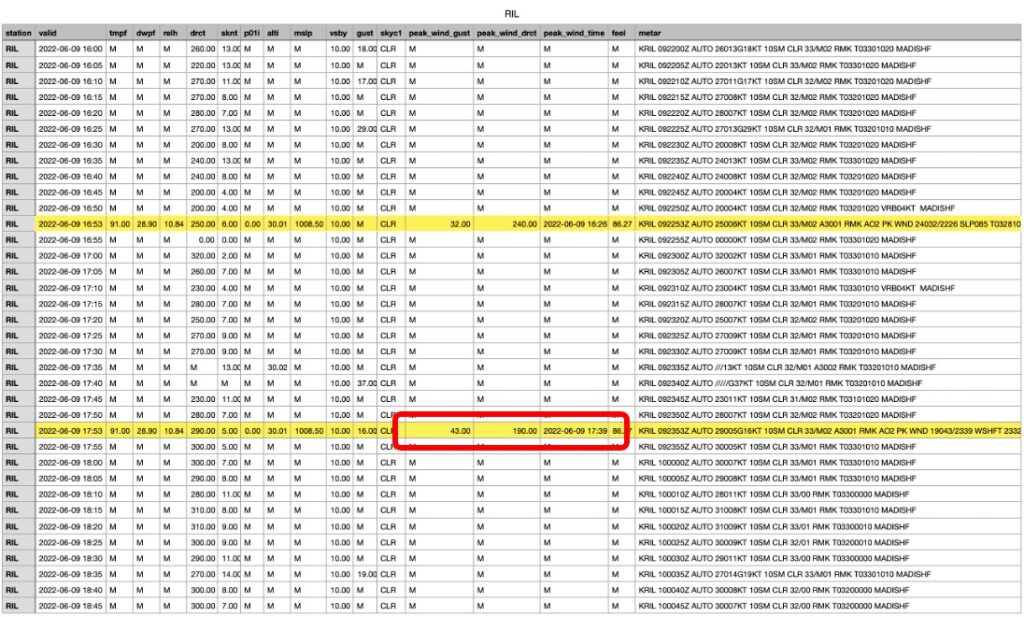
What Caused the Crash?
I believe Rick’s analysis is spot on. The deadly trap was a microburst.
“The virga produced a microburst directly over Shmulik as he was waiting for the jet. He expedited his landing trying to fly out of what was likely epic sink. While his base leg was low it looked high enough to make the runway with plenty of energy to flare and roll out. But he then got hit from behind or descended into winds in excess of 40 kts and perhaps as much as 50, stalling the aircraft and removing any opportunity for control.”
As Shmulik began his final turn he faced two closely related problems that became impossible to overcome:
-
- Extreme sink of close to 2000 fpm, which had very quickly eroded his altitude reserves during the last part of his downwind leg.
- A sudden and very powerful wind gust from behind, which caused the airplane to stall and spin in just as he was in the midst of his final turn.
Just how quickly he lost altitude may be hard to imagine; especially for pilots from regions where 2000 fpm sink is very unusual. Some basic math illustrates the magnitude: a typical safe altitude at the end of the downwind leg (before turning base) is 500-600 ft AGL. The typical time that it takes to turn from downwind to final is about 20-40 seconds (depending on how close the pilot flew the downwind leg parallel to the runway). At a sink rate of 2000 fpm it only takes 15 seconds for the plane to lose 500 ft and reach the ground. In other words: if you’re at 500 ft AGL and 20-30 seconds away from reaching the runway and you are in 2000 fpm sink it is mathematically and physically impossible to get there.
Now, you might say that the sink rate is likely to diminish as you get close to the ground. This is of course true because the air cannot sink into the earth. But that is where the second problem arises: the sudden tailwind.
Near the ground the rapidly down-streaming air is necessarily diverted into a very strong horizontal flow along the surface. At the worst possible moment Shmulik descended into that strong horizontal outflow, which came directly from behind, at speeds exceeding 40 knots, maybe more. The stall speed of Shmulik’s glider was approx. 40-43 kts in straight flight and 44-52 kts in the turn (depending on his bank angle). A sudden gust of 50 knots would have caused a stall unless he had been flying at about 100 knots indicated.
The ADSB trace shows Shmulik’s ground speed of 92 kt as he began his final turn. At the high density altitude at Rifle a ground speed of 92 kt would have been equivalent to an indicated airspeed of less than 80 kt. If this included a wind component of 50 kt from behind, his true airspeed would have suddenly dropped to 30 kt, i.e. well below stall speed.
Once the glider stalled (at an altitude of only 100-200 feet) there was nothing that Shmulik could have done to avert the crash.
As Rick pointed out, the root cause of the sink and of the subsequent tailwind was almost certainly a (dry) microburst. To understand exactly what likely happened and what we may be able to do differently, we first have to learn more about microbursts.
What is a Microburst?
A microburst is defined as “a pattern of intense winds that descends from rain clouds, hits the ground, and fans out horizontally. Microbursts are short-lived, usually lasting from about 5 to 15 minutes, and they are relatively compact, usually affecting an area of 1 to 3 km (about 0.5 to 2 miles) in diameter. They are often but not always associated with thunderstorms or strong rains. By causing a sudden change in wind direction or speed—a condition known as wind shear—microbursts create a particular hazard for airplanes at takeoff and landing because the pilot is confronted with a rapid and unexpected shift from headwind to tailwind.”
Unlike tornadoes and other twisters, microbursts are straight-line winds. The air is streaming straight towards the earth. Near the ground, it is deflected sideways in all directions. The following streamline diagram is from the November 2020 edition of Soaring Magazine which describes the Mayhem at Minden, NV when a powerful 56 kt microburst destroyed several gliders on the ground.
Wet vs Dry Microbursts
Meteorologists distinguish between wet and dry microbursts depending on whether they are associated with precipitation hitting the ground. Wet microbursts can look very spectacular but this also makes them easy to see and avoid. Dry microbursts are much more insidious because they tend to be invisible until the downburst reaches the ground. And even then, the only visible sign may be blowing dust on the surface. This time-lapse video from the National Weather Service in Reno, NV captured a dry microburst with surface winds of 71 mph. Note that you can’t see the downburst itself. Only the blowing dust on the ground is visible.
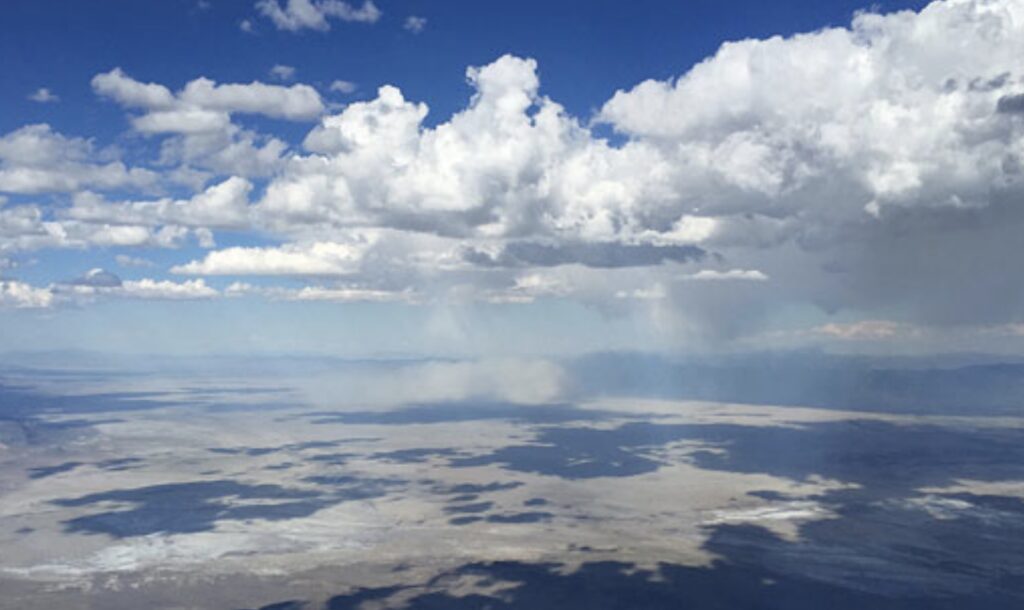
The atmospheric conditions favoring dry microbursts are illustrated in the Skew-T chart below from the University Corporation for Atmospheric Research. Note the very dry airmass near the surface and a more moist, sometimes saturated mid-level. Cloud bases are high and precipitation evaporates in the dryer layer below. This is visible as virga – streaks of rain or snow below the clouds. This evaporation causes evaporative cooling, which accelerates the downward motion of the falling air.
Once the downdraft reaches the surface it spreads horizontally in all directions. The downdraft itself is invisible. Only a ring of dust on the ground below the virga may signify the presence of a dry microburst.
The Skew-T chart at Rifle at 5:30 pm on June 9 greatly resembles the Skew-T above. Here, too, one can see the “inverted-V” shape at the bottom, signifying the very dry air near the surface and a more moist layer above. Such conditions are of course very common during the summer soaring season in the western United States.
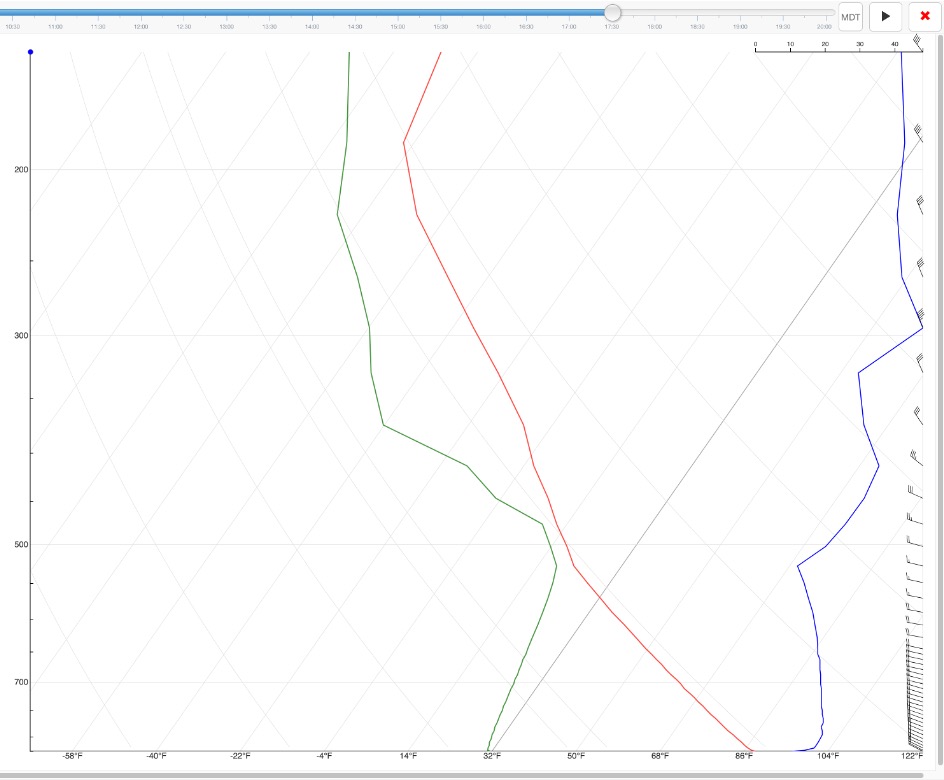
Evaporative Cooling
As mentioned, a key factor in the development of microbursts is evaporative cooling.
What is it and how does it contribute to a microburst? Everyone’s familiar with evaporative cooling: dip your hands into water on a hot dry day and feel how cool they become as the water evaporates. Evaporative cooling systems work according to the same principle.
As glider pilots we know that cool air is heavier than warmer air. So if falling rain evaporates (or falling snow sublimates), the air becomes cooler and heavier, thereby accelerating its downward momentum.
This is the exact opposite of the “cloud suck” effect that we enjoy when latent heat energy is released below cloud base, making air warmer, lighter, and more buoyant.
Virga Is a Warning Indicator
Evaporative cooling is happening by definition when virga can be observed: Virga is the visible indicator that rain evaporates (or snow sublimates).
From experience we know that sometimes there is massive sink below virga and sometimes there isn’t. Sometimes you fly through virga and you can even find yourself in lift. I cannot explain why this is the case; I can only speculate that sometimes the lifting motion is so strong that even rain and evaporative cooling cannot overcome it: in these cases the evaporative cooling may slow down the rate of ascent but it is not causing a downburst. However, if air is already sinking, evaporative cooling will accelerate the decent.
None of the pilots I asked about these phenomena claimed that they are able to reliably predict when there will be strong sink under virga and when there won’t be. And since we don’t know, I think we must take away from this accident that we have to be extremely careful when we fly below virga; especially so when we are relatively close to the ground.
Airflow Near the Surface
The following graph illustrates the airflow near the surface once the downdraft has reached the ground. You can see the air spreading out sideways in all directions.
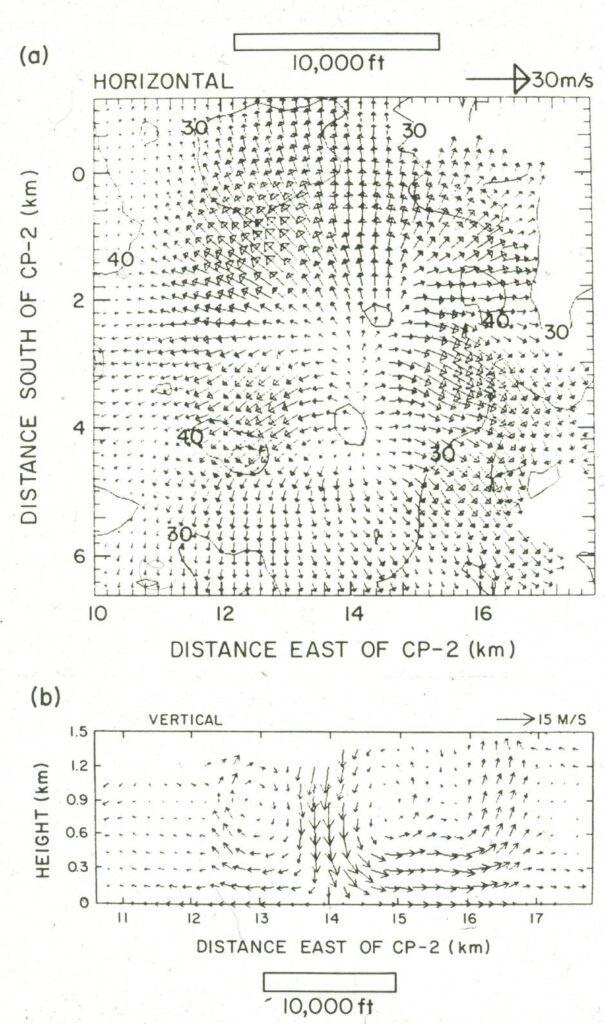
Size of Affected Area and Duration
Microbursts are usually short-lived events, lasting for only a few minutes. They also tend to be confined to a relatively small area between 0.4 and 4 kilometers (2.5 miles) in diameter.
The following graph depicts a vertical cross-section of a microburst over time. Note the scale in kilometers. The microburst event begins a few minutes before the burst hits the ground and can last for about 10 minutes after the initial divergence begins at the surface.
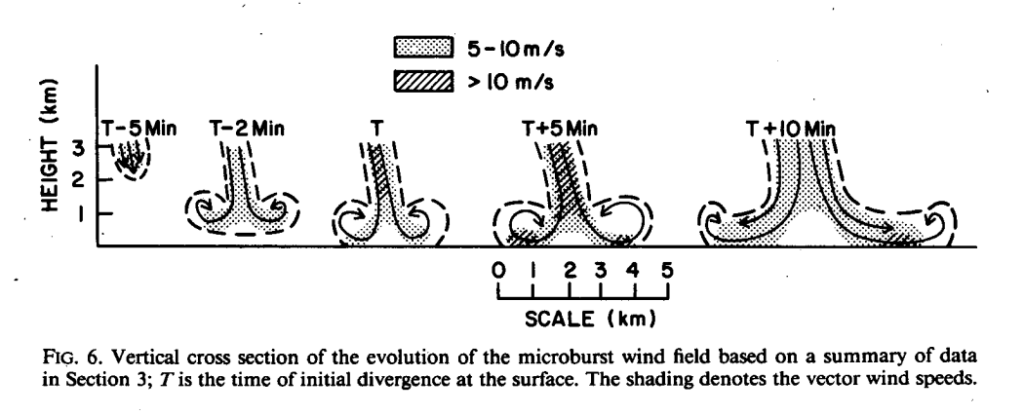
Much more details about the structure, shape, and duration of microbursts can be found in this article by Mark R. Hjelmfelt from the National Center of Atmospheric Research in Boulder, CO.
How Common Are Microbursts?
On summer days with strong convection, microbursts are a frequent phenomenon, especially in the dry climate of the Western United States.
In the summer of 1982, the JAWS (Joint Airport Weather Studies) program was set up to detect and observe microbursts near Denver’s Stapleton International Airport. Within 86 days a total of 186 microbursts were observed within a relatively small geographical area northeast of Denver. Microbursts were detected on more than half of these days. 83% of the microbursts were dry. (Source: Fujita/Wakimoto, JAWS Microbursts Revealed by Triple-Doppler Radar, Aircraft, and PAM Data)
99 of these microbursts were just within 10 nm of Stapleton International Airport. We can probably conclude from this that in the arid climate of the western United States microbursts are par for the course: They likely occur on almost every good summer soaring day.
How Does It Feel in the Cockpit When We Encounter A Microburst?
What we experience in the cockpit differs greatly depending on our altitude (and on the stage of the microburst’s development when we encounter it).
Microburst Encounters at Altitude
Imagine that you fly through the descending shaft of the microburst as illustrated below.
In this case, the only indication of a microburst may be very strong sink. The onset of the sink could be quite sudden such that you bump your head on the canopy, or it can come about more gradually over a period of a few seconds. In the western US, where we often fly 10,000 feet or more above the terrain we might not notice anything particularly unusual. We have all have flown through patches of very strong sink lasting for about 30 to 90 seconds. We might have been slightly annoyed that we just lost one or two thousand feet of altitude but that is likely all we noticed. Cruising at 80-100 kts we cover almost two miles per minute. Normally, this is more than enough time to traverse through the confined area of most microbursts.
If we encounter the microburst a little earlier in its development, i.e. just when the air is beginning to drop past our flying altitude, we may also experience more turbulence and wind shear when entering and exiting the burst. However, even then it seems rather unlikely that we would get in real trouble (provided that we are still at a safe altitude once we exit the sink).
Microburst Encounters Closer to the Ground
The encounter is quite different when we fly closer to the ground because we are now confronted with the horizontal outflows. The lower we are, the more dangerous the situation. The above referenced study by Wilson, Roberts, Kessinger, and McCarthy suggest that the greatest danger is at altitudes below 1000 ft AGL. The reason is that we first encounter a headwind followed by a tailwind as we fly through the outflow area near the surface. The difference in speed between the headwind and the tailwind tends to be greatest at an altitude of about 200 ft AGL. Consider the illustration below.
In this case we are likely to encounter a sudden headwind and therefore a surge in kinetic energy causing the glider to rise and accelerate, soon to be followed by a sudden tailwind and a rapid drop in airspeed that could force our glider to stall unless we were able to maintain a sufficient airspeed margin.
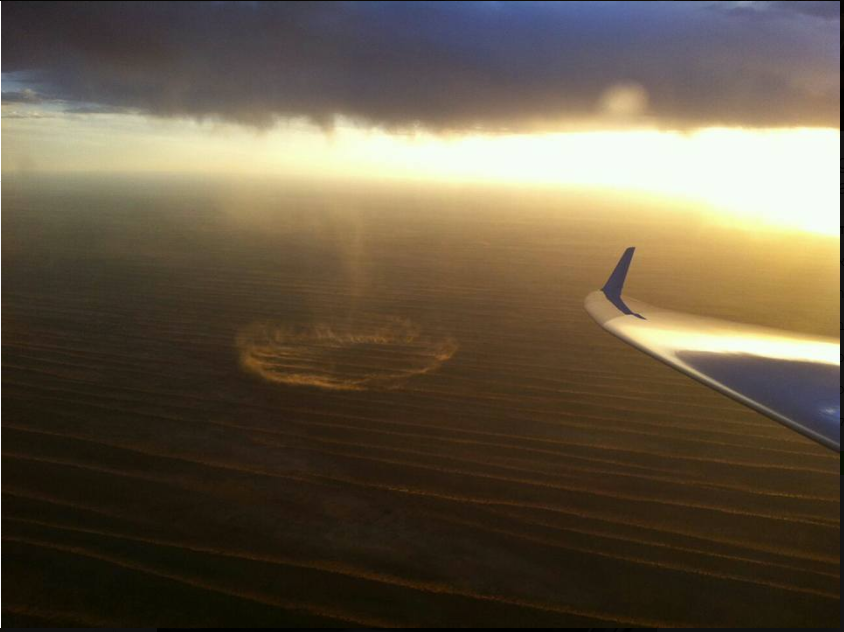
The Greatest Danger is Below 1000 ft
The lefthand side of the following chart illustrates the differential in wind speed between the headwind and the tailwind at different altitudes for 12 different microbursts. The solid line is the average.
You can readily see that the greatest wind speed differential, i.e. the greatest wind-shear is at altitudes below 0.2 km (i.e. ~600 ft) with the peak of the average at less than 0.1 km (about 200 ft). With increasing altitude the wind speed differential (and therefore the danger) decreases. In some cases it can be measured up to about 0.6 km (~2000 ft).
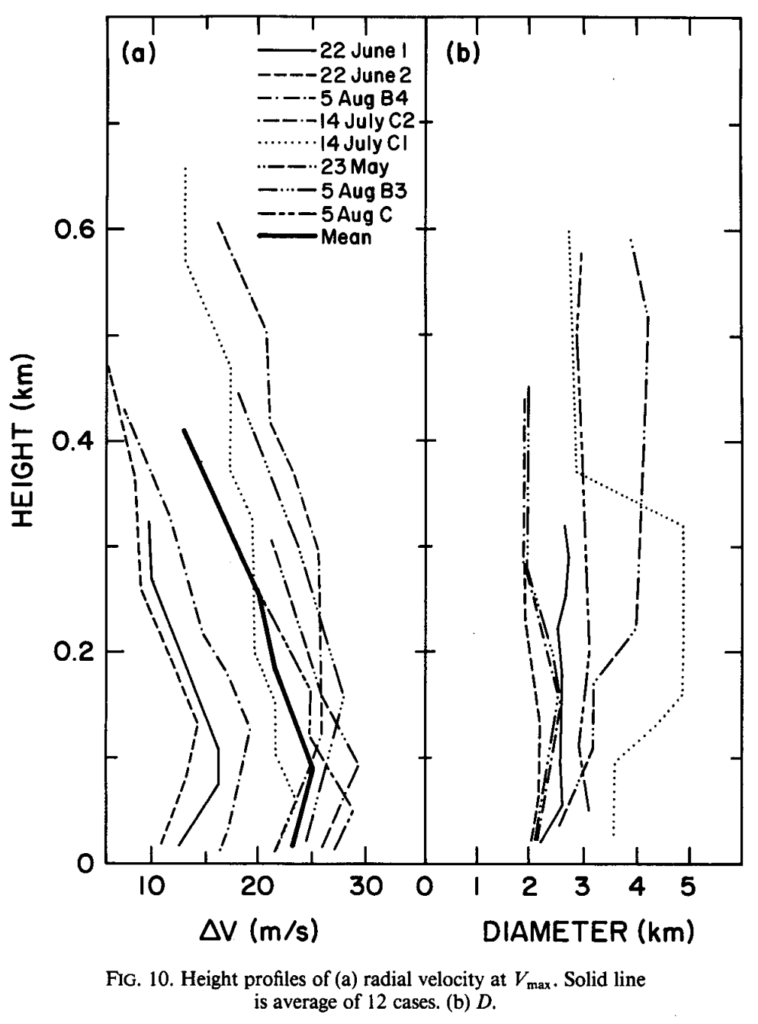
Reports in Soaring Magazine
Over the years, Soaring Magazine has reported on a number of such harrowing microburst encounters at low altitudes. These were from pilots who were not quite as unlucky as Shmulik and lived to tell the tale.
Trish Durbin quotes Joe Carter in the September 1987 edition as he tells about his microburst encounter during a Region 9 contest in El Tiro near Tucson, AZ.
“There was an opening between [two storm cells]. I was doing about 80 knots and all of a sudden I hit this tremendous sink. I put the nose down 45 degrees to speed up and I was still doing about 80 knots. The controls became very sloppy, I just couldn’t figure out what was going on. The ship wasn’t behaving the way it normally would. It was very sloppy as if it were ready to stall, but with 80 knots indicated air speed. The varios were pegged down; I finally got it to about 120 knots by putting it almost vertical and then started pulling out of the dive slowly because the ground was coming up fast. I was probably about 200 feet above the terrain.” Joe got very lucky and landed safely in a field several miles away.
Bill Gawthrop writes about his crash in Truckee, CA in the September 2015 edition.
“I checked AWOS to get conditions prior to my landing approach, and heard winds 220 at 7 gusting to 15 knots. This was nearly straight down runway 20, the normal glider runway. I knew to be cautious because just north of runway 20 we often experience downdrafts as the runway drops off steeply, at about a 40-50% slope. I made a short pattern to minimize the time I spend in the down air. I turned final about 400 feet north of the runway about 180 feet above the runway.
Suddenly, I was dropping like a stone, being pushed into a left turn by the wind. I immediately pushed in the spoilers, hit hard right rudder, and hard right stick. The glider, after what felt like a freefall, started to respond to my inputs about the time I dropped below the runway. I could see I was too low to make it back up to the runway elevation. … Witnesses said I had cartwheeled over the runway lip onto the taxiway, landing backwards but right side up.
According to the weather records the winds had shifted suddenly to 260 gusting to over 20 knots about the time I arrived, lasting only a minute or two. The downdraft … struck at a much higher altitude than would be expected for a rotor off the trees and the descent was very rapid. I suspect that a small microburst that lasted only a short time forced the apparent downdraft that I experienced.
The strong gust of wind was 60 degrees from my flight path. My forward speed relative to the wind would have dropped significantly when I passed through the wind shear of this oncoming gust causing the wings to significantly lose lift. So rather than a down draft causing the violent drop it could have been caused by the wind shear. “
More insightful stories about powerful downdrafts as well as sudden updrafts can be found in the excellent article “Rogue Air Currents” by Bob Thompson in the October 2014 edition of Soaring.
Everything Fits
Now that we understand a lot more about microbursts we can readily see how all indicators fit together.
Shmulik was supremely unlucky because he flew directly through the center of the downdraft when he was on his downwind leg. And then, just as he started to make the turn from base to final he was hit by the microburst outflow coming directly from behind. At that point he had descended to an altitude of approx. 200 ft where the strength of the outflow is typically the strongest.
The following charts show radar images for 5:30 pm, 5:35 pm, and 5:40 pm. The purple circle shows the small cell from where the downburst most likely came from.

AWOS reported the strength of the gust on the ground at 43 kts. Based on the data from the research study referenced earlier it is likely that at 200 ft AGL the outflow speed was about 10-20% greater than near the ground. I.e., 50 kt or slightly higher. Shmulik would have needed to fly at an IAS of around 100 kt to avert a stall and have a chance of maintaining control.
The time duration of the event was very limited, just as would be expected. After the gust had come through, AWOS went back to reporting light winds out of the west.
That’s when the other three glider pilots returned to the airport, just minutes later. Based on their flight traces, all three landings appear completely normal and uneventful.
Rick Roelke followed Shmulik, touching down at 5:45:36, i.e. less than 8 minutes after Shmulik’s crash. Bill Feiges was next, landing at 5:47:38, followed by Sean Franke who landed at 5:50:51.
It is worth noting that Shmulik had started his landing pattern significantly higher (!) than any of these three pilots: the altitudes of these three pilots on downwind at midfield were between 875 and 1148 ft AGL, i.e. typical and normal pattern altitudes. Shmulik had been at 1339 ft AGL at an equivalent position in his pattern. This means Shmulik had the greatest safety margin of all of them. Also, none of these three pilots flew at a higher speed in the pattern than Shmulik did.
Could The Accident Have Been Averted?
This is very hard to say. Perhaps the most important questions is whether the amount and location of the virga should have been so concerning as to prompt a reasonable pilot to delay their landing and wait at a safe distance for the virga to dissolve or move away.
Should the Landing Have Been Delayed?
Without being able to see the sky like Shmulik did, this is of course impossible to say. However, by all accounts none of the pilots operating at Rifle at this time were overly concerned about the extent of the virga. Everyone’s behavior suggests that many if not most pilots would have proceeded with the landing just like Shmulik did.
-
- Rick’s report stated, “There was virga over the airport (elevation 5537 ft) and to the north of the valley, and northeast as well. None of the wisps extended below 11,000 ft (cloud base was approximately 19,000). Cloud cover was scattered. The clouds producing virga were not towering – they were perhaps a bit bigger than non-producing clouds, but not much. It was a point of interest to me as we don’t see a lot of it in the eastern US – I was wondering what drove the difference.
- Bill Feiges, one of the other pilots flying that day, wrote, “I did not think there was enough virga in the area to catch my immediate attention.” Bill is quite familiar with the weather in this area as he normally flies out of Steamboat Springs, CO, just 80 miles to the NW of Rifle.
- The pilots of the Challenger jet were clearly not overly concerned either, otherwise they would not have been taxiing to the runway for takeoff.
- Plus, none of the three glider pilots thought it necessary to delay their landing even after Shmulik had already crashed.
Bad Luck
Unfortunately there was a tremendous amount of bad luck involved:
-
- The occurrence of a microburst with extreme sink in the pattern just as Shmulik returned from his flight;
- The delay caused by the intended Challenger launch, which likely prompted Shmulik to fly to the south side of the airport exposing him to more sink and the sudden tail wind (instead of a head wind) on the turn to final;
- The lack of a radio response from the Challenger which may have hampered Shmulik in his decision making (e.g. preventing him from landing straight in on runway 08 when getting low); and
- Encountering the tremendous tail wind just as Shmulik was making his turn to final, i.e. at the worst possible moment, and at the worst possible altitude.
If only one of these factors would have been different it is quite possible – perhaps likely – that the outcome would have been different as well.
It is hard to argue that Shmulik did not have sufficient altitude when he returned to the airport at almost 3000 ft AGL with only 2 miles to go. Or that he flew unusually slowly in the pattern. The three pilots returning after Shmulik were aware that there had been an accident. They would have been exceptionally careful. And yet, none of them returned to the airport with more safety margin than Shmulik did. None flew faster in the pattern.
I believe that any of us – if put in Shmulik’s position – may have done exactly the same thing he did. Any of us could have suffered the same outcome. Indeed, it is tempting to conclude that this was indeed Shmulik’s fate. That nothing could have been done differently; that none of us can do anything different. Even, that nothing can be learned from this.
I sincerely hope that this is not true. I am the first to admit that based on what I knew before doing this detailed analysis I would likely have acted just like Shmulik did. But that is not the same as to say that I won’t change anything in my flying going forward. I believe that there has to be, and that there is, something that I and others can learn from this.
Is There Anything To Learn?
I believe the answer is clearly “yes”. The following summarizes my personal takeaways. You may need to adjust these based on your flying environment, your experience and skills, and your glider.
Recognize the Potential for Microbursts
First, there are a few facts about microbursts that I will try to remember:
-
- Microbursts are a common summer-day phenomenon. In the Western US they occur on practically any good summer soaring day.
- Microbursts do not just develop below towering cumulonimbus cells. They can occur under any mature cumulus cloud that is starting to dissolve, especially if there are signs of precipitation below cloud base.
- Dry microbursts are invisible. The only visible indicator may be a ring of dust on the ground emanating from the center of a downburst. However, dust can obviously only be noticed after the microburst has already reached the ground. You may not be able to see it in time!
- Virga is an indicator that microbursts may be present because virga is a tell-tale sign of evaporative cooling, which accelerates any downward movement of the air.
- Microbursts can be extremely powerful and the sink alone can be overwhelming.
- Near the surface, strong sink from a microburst is typically followed by a sudden and powerful tailwind, no matter in which direction we’re heading. This is a consequence of the fact that the down-streaming air is deflected outwards in all directions as it hits the ground.
- The greatest risk of sudden tailwinds exists below 1000 ft with a peak wind differential at around 200 ft AGL. That’s why microbursts are so dangerous in the landing pattern.
- In addition, I will remember that AWOS reports are outdated. Microbursts occur suddenly and the reported wind speed necessarily reflects what happened in the past, not what is currently happening. There can also be a substantial time delay in the reporting.
Anticipate and Avoid
Second, the best strategy to minimize the risk of getting caught in a microburst at low altitude is to anticipate and avoid it. Practical strategies I will use going forward are:
-
- If there is any indication of overdevelopment or virga I will adjust my final glide approach such that I plan to arrive at the target airport with a minimum altitude of at least 3000 ft AGL. This will give me more time to assess the conditions and make alternative plans.
- If virga is present above or immediately next to my landing site I will attempt to delay my landing by staying in rising air at a safe distance and altitude and wait for the virga to move away or dissipate completely. This usually only takes a few minutes.
- If this is not possible I will divert to a different airfield or landing site provided that the conditions look more favorable.
Modified Landing Pattern if Necessary
Third, as a last resort, if I must land despite the presence of virga above or next to the field I will modify my landing pattern as follows:
-
- I will enter the landing pattern much higher than usual. This may be as high as 3000 ft AGL to allow for the possibility of massive sink on the downwind leg. (I will also announce this unusual pattern on the radio so other traffic is not taken by surprise.)
- I will plan to maintain a substantial altitude safety margin throughout the pattern and complete my final turn while still at an altitude of approx. 1000 ft AGL, planning to fly a very steep final approach. Completing the final turn around 1000ft will significantly reduce the risk of a sudden gust from behind, especially while turning.
- I will fly at a much higher pattern airspeed. This is especially important once I get below 1000 ft because that is where a gust from behind is most likely and also most dangerous. If there is any virga in the vicinity I will fly at a minimum IAS of 80 kts (20kts above the yellow triangle speed). If I encounter sink in the pattern I will immediately increase my airspeed further. As a rule of thumb I will add extra airspeed equivalent to my sink rate. E.g., if my sink rate is 10 kts (1000 fpm), I will add another 10 kts and fly at 90 kts IAS. If my sink rate is 20 kts, I will fly at 100 kts IAS. The stronger the downdraft, the stronger the potential tailwind once I get close to the ground. I think this airspeed adjustment will better protect me against sudden tail gusts or descending into a sudden tail wind.
Communication and Training
- I realize that flying such an unusual pattern can in itself be a risk. There are two concerns in particular:
-
- Other traffic may not anticipate it and be taken by surprise.
- I could misjudge my altitude and overshoot the runway.
With respect to the first concern, I will mitigate it by clearly announcing my intentions. I would also hope that such a pattern is rarely necessary because I intend to avoid to land in such conditions whenever possible. This pattern is a last resort.
With respect to the second concern, it is something that I will deliberately practice when there is no other traffic in the vicinity. It is clearly helpful to get accustomed to the sight picture of finishing the turn to final at 1000 ft AGL and making a spot landing at the normal aim point. I am fortunate that my glider has very powerful airbrakes, which allow for a very steep descent if necessary. This approach may not work for gliders with less effective spoilers.
Learning From My Own Mistakes
I looked through my own inflight videos and found the following one from a flight on June 7, 2021 that illustrates a broadly similar weather situation to the one Shmulik was likely facing.
I’ve Been There Before
I recommend you begin to watch at 31:54. The similarities include:
-
- Virga directly above and in the vicinity of the airport.
- I was at a similar altitude as Shmulik when I had 10 miles to go.
- I encountered extreme sink of 20 kts in the vicinity of the airport, directly below virga. In retrospect, this was also likely the result of a microburst. (I did not encounter a sudden tailwind when exiting the sink because I was still a few thousand feet above the ground where sudden tailwinds are not likely because the down-streaming air has not yet been deflected.)
- There were signs on the ground of an approaching gust front suggesting strong wind shear in the area.
- The flight was during dynamic summer soaring conditions in Colorado at the same time of year (June 9 vs June 7), albeit at different airports.
- The field elevation at Boulder is 5288 ft which is similar to the elevation at Rifle at 5536ft.
Compared to Shmulik, I was simply more lucky at the end. Before I entered the pattern, the severe sink stopped. I also didn’t get hit by a gust from behind on my final turn. Plus, I wasn’t distracted by another aircraft trying to take off from the same runway. If it weren’t for these key differences, the outcome could have been the same.
Relying on Luck Is Not A Strategy
However, in the future I don’t want to leave the differences to luck. Based on what I learned from Shmulik’s crash there are several things I will do differently from what I did in the video:
-
- I will maintain more altitude on days like this before approaching the airport. Note how – in the video – CX came back several thousand feet higher than I did. In conditions like these, altitude can be lost very fast! In the video you hear me joke at 32:52 that CX is too high. No, he wasn’t! He made a smarter decision by climbing up while on final glide. This put him into a safer position with a lot more options!
- I will seek to avoid a landing while there is virga directly above or next to the airfield and a gust front is approaching. You can see in the video that I considered diverting to Longmont but then the extreme sink over Boulder forced my hand. CX had the additional altitude he needed to either wait the situation out (which he did) or divert to nearby airports. CX landed 12 minutes after me when the gust front had passed through and the winds had calmed down.
- I will accelerate immediately when I hit extreme sink. You can see that my airspeed fluctuates between 70-80 kts as I hit 20 kt sink (starting around 37:00). I should have pushed the nose down immediately, accelerating to at least 100 kts, if only to fly out of the sink faster (I was at an altitude of about 3000 AGL and a sudden gust from behind is not likely until closer to the ground).
- I was not much above 1000 ft AGL when crossing midfield to enter a right pattern to Runway 26. As explained above, in similar situations I will enter the pattern much higher in the future to guard against potential sink on the downwind leg. (And I will not waste time by flying in circles listening to AWOS which may be outdated anyway. I should just focus ob observing the wind socks and the surface of the lakes.)
- My target airspeed in the pattern was 75 kts and my actual airspeed fluctuated between 70 and 80 kts. I believe this was too slow, especially during the turn to final that I started at an altitude of about 700 ft AGL. It would have been better to fly that last turn 300-500 ft higher and faster (and a little further east of the runway). I should have never been below 80 kts in the pattern. This also includes the last portion on short final. It is important to maintain the extra speed until I get into ground effect where the risk of descending into a sudden tail wind no longer exists.
Final Thoughts
Writing this article has been difficult. However, I sincerely hope that it was worth it. Unfortunately it won’t help Shmulik. But I know that it will help me and hope that you, too, find it valuable. I am not a fatalist and I like to avoid leaving things to chance. I know that our sport is objectively dangerous. But I also know that if we are willing to do the hard work that it takes to learn from the accidents of others it does not have to remain quite as dangerous. I hope this analysis is another step in that direction.
Disclaimer: this analysis is not intended to preempt or substitute the official NTSB accident investigation. It is solely based on information that I had ready access to. More information may come to light (e.g. by analyzing the more detailed igc trace rather than the ADSB trace). My analysis also includes interpretations that are necessarily subjective.
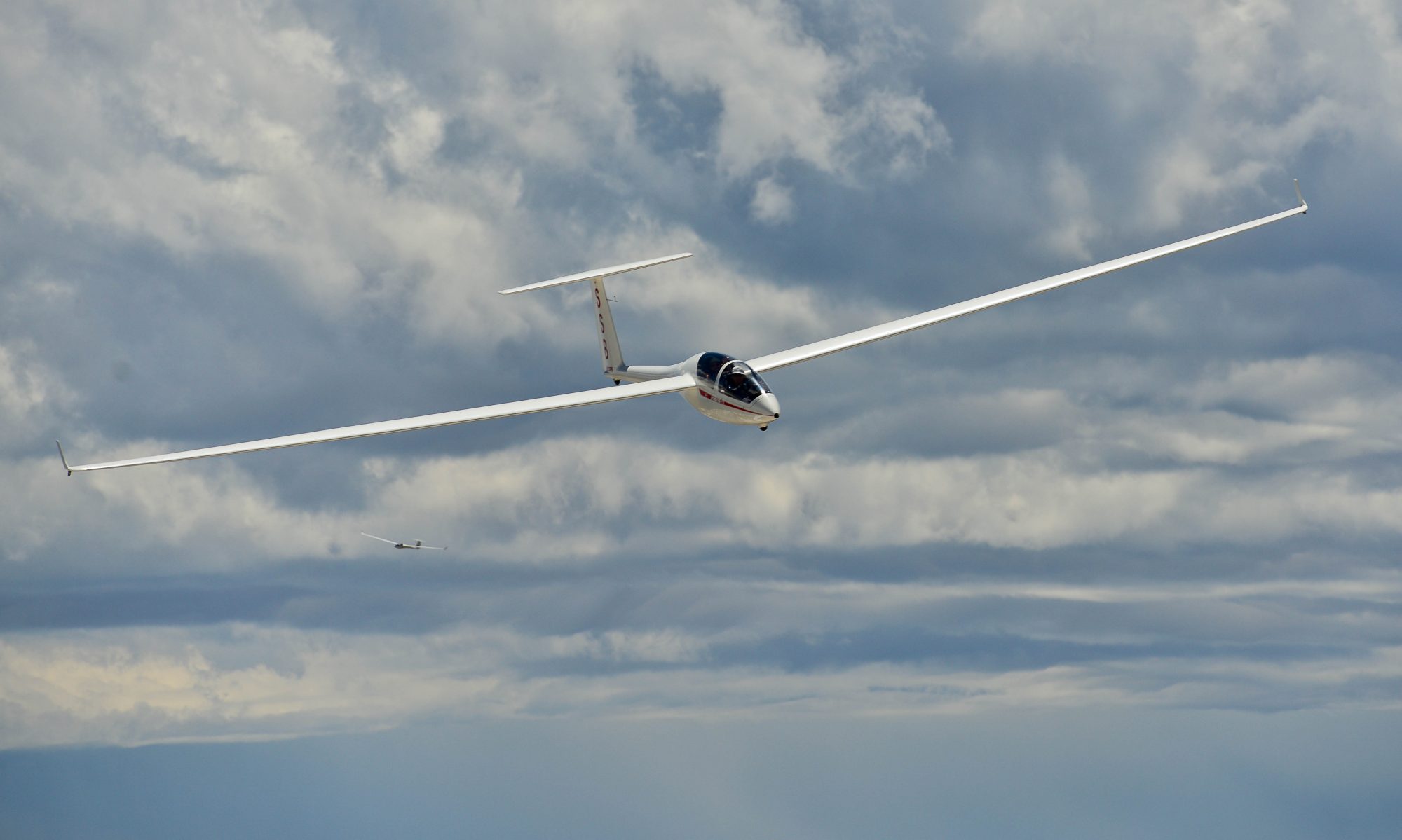

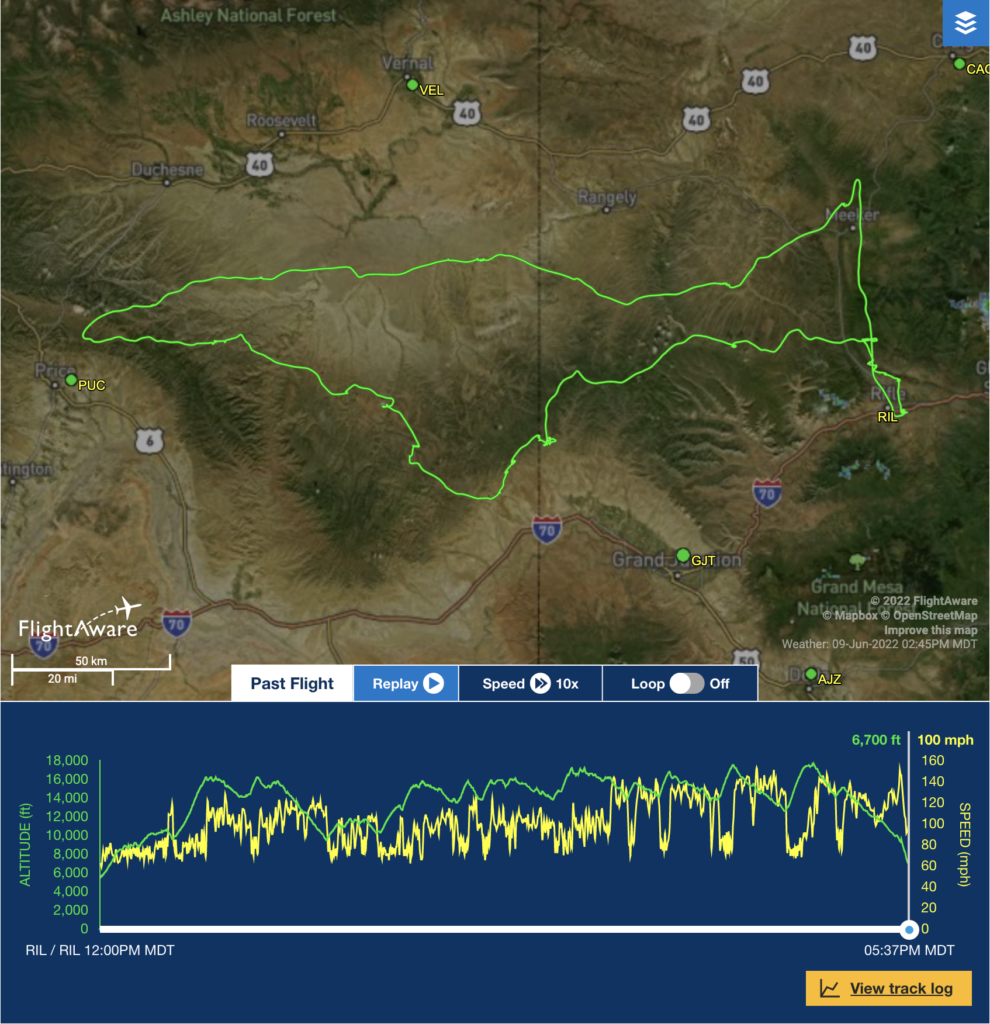
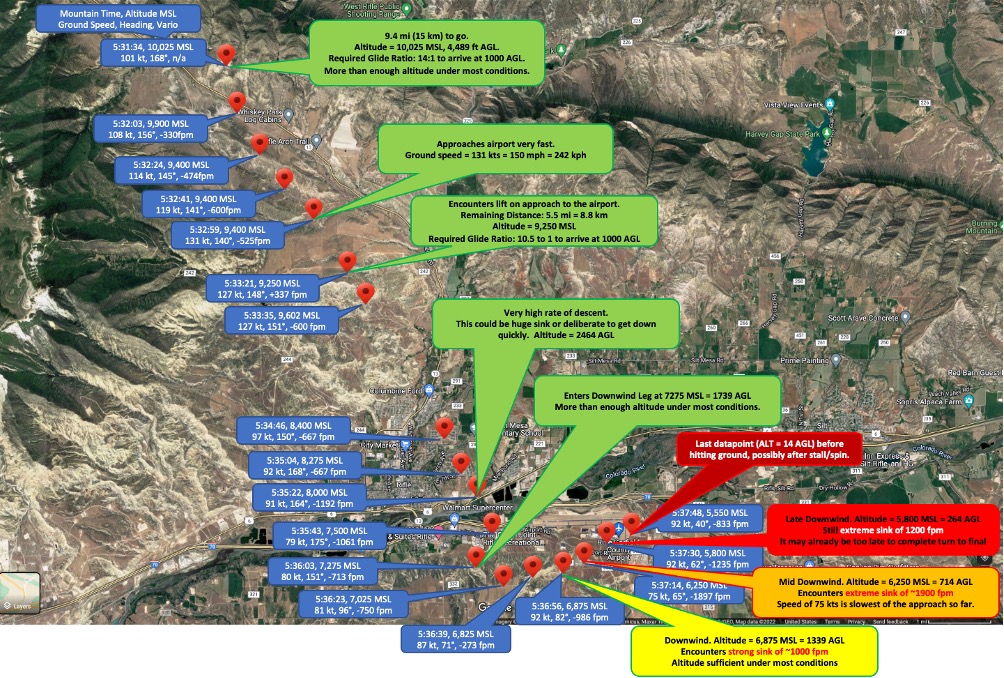

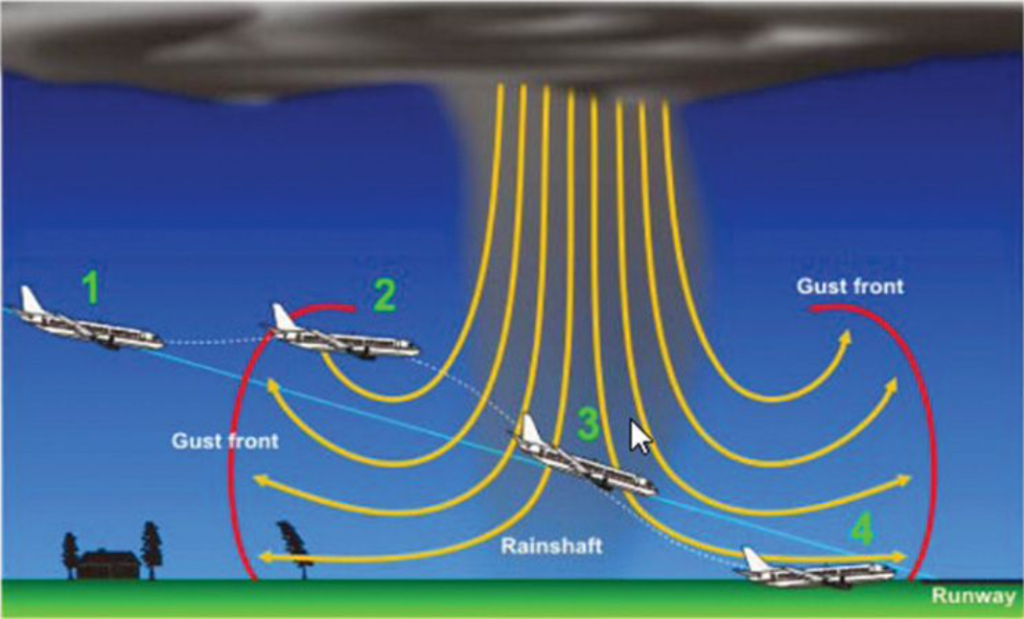
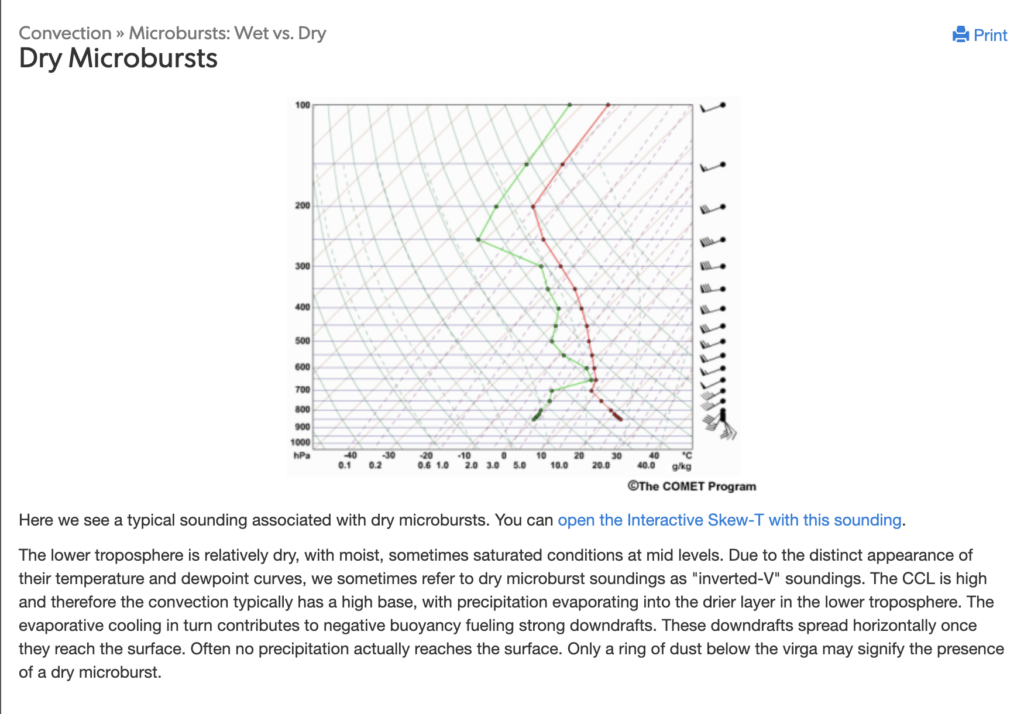
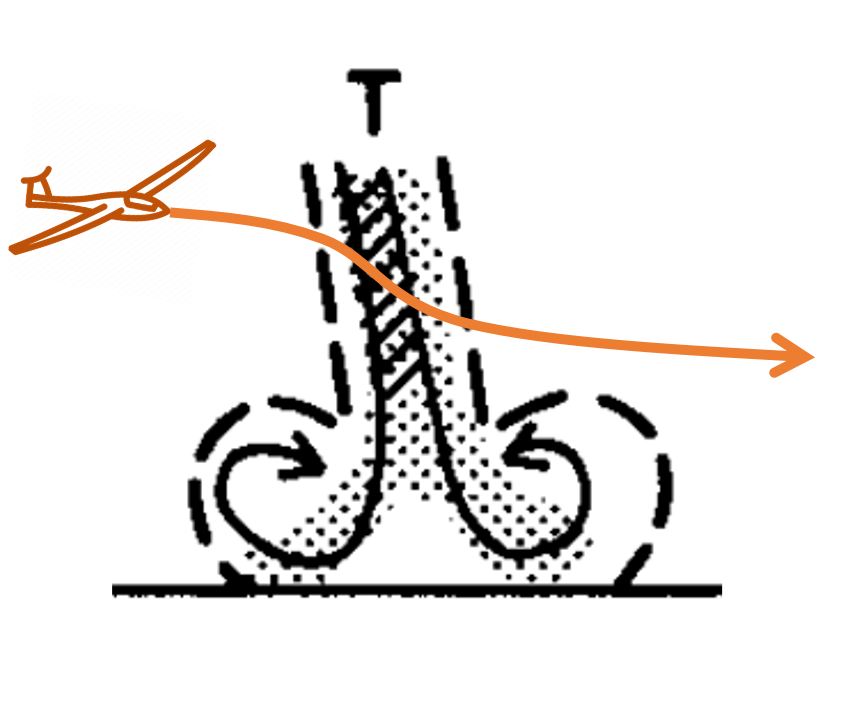

Clemens: Thank you for investing the time and effort to think through and document the issues, and make positive suggestions to reduce risk of fatalities. Your re-emphasis on the necessity of early recognizing, deciding and then acting on all available information is a material contribution to soaring safety. Your recommendations are also a reminder to pilots that modern gliders’ powerful air brakes and positive flaps enable very steep final descents and therefore very high pattern altitudes when conditions warrant.
Excellent thought-provoking analysis. Thank you. I’ll just add one small additional comment: In addition to bodies of water, fields of crops and any source of smoke can also make otherwise invisible microbursts and gust fronts visible. Those markers have alerted me on several occasions. Safety is no accident!
Thanks Marc, yes, good point about looking for all kinds of indicators that may give away strong surface winds.
Hi Clemens,
many thanks for this very detailed analysis – it is said to hear
that another fellow pilot lost his life in performing our fantastic
sport which i am doing also since excess 50 years and in
many countried (unfortunately not yet in the US).
Based on personal experience in Mikolovice (wave camp in Czech Republic last year ) it may be interesting to note that it is not
only virga producing such dangerous situations.
When i came to final on one day (at high speed of abt 90 Knots)
i was completely out of the blue hit by a very strong turbulence
turning my glider (ASH 26 E) to roughly 90 degree roll –
i reacted fortunately very quickly and had enough height to
be able accelerate immediatly further and went down to surface on purpose and flew low over the field at high speed.
Nothing happened to me – but two other pilots crashed their
gliders in the final (fortunately no personal injuries).
The rest of the camp was uneventful.
So what to take from this?
Our sport brings every day new challenges and weather
conditions.
We have to be aware that mother nature might have something up for us – just be trained and focus on many things
as you righly comment.
I very much appreciate your videos and analysis – thanks for
them and keep it coming.
My thoughts are with family of your fellow pilot – may he rest
in peace.
Sincerely yours
Andreas Redlin (ASH 26 E – D-KKAP)
Thanks Andreas for sharing your insights! Yes, you are of course right to point out that microbursts are not the only cause of severe windshear near the ground. Rotor turbulence on wave days can easily do the same thing. In Boulder we regularly have situations where the two windsocks on either side of the field point in opposite directions when there is wave. Since we’re in the lee of the Rocky Mountains wave is very common and everyone tends to be super careful on wave days. The microburst situation is something that took me by surprise, at least the magnitude of it. Thanks again for your contribution!
Hi,
Thanks for your article. It is a fascinating read as always.
An observation: I’m not sure that the increasing tail wind from the downburst causes the stall of the glider. I think the root cause is windshear/turbulence.
As a beginner glider pilot, it’s hardly my place to question this but I think it’s important enough to post this comment.
Thanks,
Bogdan
Hi Bogdan, thanks for sharing your thoughts! I think this may just be semantics. The term wind-shear just describes a situation where wind speed and/or wind direction change in close proximity. So, yes, it was of course this sudden change in wind direction and speed, i.e. windshear, that caused the stall. The windshear itself was caused by the downburst and the subsequent deflection of the wind near the ground (because it can’t continue to go into the earth). You are right that the wind did not suddenly catch up to Shmulik from behind at a given altitude. The massive sink forced Shmulik to descend through the windshear layer where the wind was suddenly coming from behind. The end result was still a sudden tail wind which caused the glider to stall. And yes, the air along the shear line tends to also be very turbulent. Thanks again!
Downburst can be in line form and last for hours in Arizona. Last 4 days we have many of them daily. https://laughingsquid.com/haboob-decade-of-dust-storms/#:~:text=Stormchasing%20filmmaker%20Mike%20Olbinski%20captured,a%20decade%20of%20dusty%20haboobs.
Hi Ryszard, thanks for sharing the video! Spectacular time lapse! Even in Colorado we get haboobs from time to time. Fortunately they tend to be easier to spot than an invisible microburst.
Thanks for the write up. As #2 for landing that day I would like to add a little more info. The 2nd officer of the challenger was very helpful in transmitting the crash to us, and later telling me (at my request) that the runway was clear. But She did not communicate the strong gust. We knew of the sink (reported as strong) and I planned accordingly. But in hindsight I was not flying a pattern that could have prevented issues if I had been delt the same conditions. I agree with your conclusions, and that the scale of this event was much bigger than any of us plan for. It is worth noting that runway 26 at rifle is 8000 ft long and we regularly try to use as little of that as possible. We do have space to bleed off lots of surplus speed. Hopefully we can all learn from this and increase our margins accordingly.
Rick, many many thanks for sharing your insights about this crash. Without it I would have had too much to guess to do the analysis. I plan to add a post scriptum highlighting the importance of good communications. Bill Feiges pointed this out to me as well. We really all need to speak up immediately if we see something that could help someone else who’s up there facing impossible threats. Thanks again! Clemens
Sorry, 26 at rifle is 7000 ft…
Thanks Clemens, truly spot on.
Be careful out there,
Best Regards, Dave
Many thanks Dave, this means a lot coming from you!
Clemens … I am requalifying in gliders after 20 years. This was an astounding article you penned …. deep analysis in aerodynamics, weather phenomenon, and strategy to mitigate risks. Lots to think about after reading and, viewing your YouTube video. I will save your work for future refence.
Many thanks for the hours you spent creating this …
Thank you!
Hey Clemens. Thank you for this very detailed write up. I’ve experienced a few rounds of microbursts, and some that didn’t look threatening whatsoever. The big difference is I was in a relatively heavy jet. We have power, sure, but it takes a few moments to get the engines going again. For those few moments: we are in the same predicament.
In the column on RAS I discussed what I will say here: our total energy is not just airspeed. Our total energy is a combination of airspeed and groundspeed along with altitude. If we are at 30kts indicated but 80kts GS we have a big problem at 200′ AGL.
The Airbus does this nifty thing where it manages a faster speed when it sees a lower than expected groundspeed. Why? It does this to account for the loss of the headwind we are experiencing (and thereby the groundspeed) which leads to: a continuous groundspeed approach. It will accelerate all the way up to VFE -5kts if necessary, then slow down at 100′ AGL in case it has miscalculated. I’m sure there is a video on this on YouTube. It’s called Ground Speed Mini.
Another thing I mentioned is if our glide computer manufacturers could develop a warning for windshear. We certainly have the data input to get there. But a huge diverging groundspeed vs indicated airspeed is either boundary winds gone mad, rotor, or a downdraft. It’s very possible to predict a microburst once you have begun entering it based off of the data we have now. No radar required.
Thank you Clemens
Hi Jason, thanks for sharing your experience with the Airbus. Some smart technology there. Yes, a wind shear warning would be nice to have even in the glider and I can see how it may be programmed to detect it based on a sudden variance in ground speed vs airspeed. We are of course more limited in our means to respond (given the lack of an engine) but I suppose it would help to immediately put the nose down when encountering the sudden headwind may help to pick up the airspeed necessary to survive the subsequent drop in airspeed as we enter the tailwind a little late. As you point out we also need the altitude necessary to execute such a plan. Our energy is indeed a combination of both altitude and airspeed. Thanks again for the insightful comment!
In my narrow escape from a vortex / downburst encounter at 300′, my Oudie recorded TAS and groundspeed (among other parameters) in one second intervals which enabled me to chart wind in the x and z axes over altitude and distance.
As others have observed pointing your glider straight down in a downburst might not get you much in the way of airspeed. But I ended up at the bottom (10′ up) with enough to climb over a berm and wires.
Terrain, tree and structures can also produce vortices and downbursts.
Detailed information here:
https://drive.google.com/drive/folders/0B1NeKc6B2S3XeDY0Q1Z6NXdsd2s?resourcekey=0-HMr9FEeYd1ZUuNPA7qlLRg
Hi George, many thanks for sharing this incident and the detailed analysis that goes with it. It seems like the diameter of the downburst that you encountered was extremely small (~300m / 1000 ft) such that you were able to transit it in just 9 seconds. The windshear shows the typical microburst pattern of a headwind, followed by freefall, and then a strong tailwind. All at very low altitudes, much lower even than in the downburst events studied by the JAWS Program. It seems pointing the nose down immediately was the critical action allowing you to pick up enough speed to avoid a stall upon pulling out just as the tailwind component hit you. And it seems that is perhaps the most crucial element to survival. Is this short characterization accurate?
Of interest to me is also the air speed limitation of your glider in landing flaps configuration. My Ventus 2 can use landing flaps up to 108 knots so I typically don’t think about flap-related airspeed limitations at all when I am in the pattern.
Thanks again for sharing all this!
Hi Clemens,
The Wind Velocity Chart generated with MatLab is of course only a 2D transect of a much larger formation. There no data sufficient to identify what section of the downburst I transited. The crosswind component is entirely missing, because heading is not available.
My peak altitude in the chart shows me in the core of the vortex. The strong opposing wind vectors before and after the peak indicate a vortex, especially given the miniscule wind vector at the peak.
Exiting the downburst, the chart shows air bouncing back up with little horizontal component. The berm may have contributed to this.
As for the small headwind component before I got kicked up 10 m in the space of two seconds working out to 300 m/minute – that was close to the wind on base.
Thankyou from Oz
One of our best pilots had his LS6 destroyed as he touched down by a dust devil so even at 1 m height sh… can happen
Also only 160 miles inland we get a sea breeze hit the east end of runway 14 while westerly still blowing in 1km away at the 32 end
Looking outside what counts most Dams dust wind socks trees leaves plus radio calls from other pilots landing if required
Very good writeup and thoughtful analysis. I’m only reading it now after returning from a week at Ely. We had microbursts every day from the 25th to the 1st when I left. Virga Bombs starting as early as 9:30am around Ely and then visible on many of our southern routes where conditions are drier and the outflow was much more apparently. The Rifle crash was certainly on our minds.
Myself and others were tending to fly our patterns very high, very steep and very fast. 80-90kts with an aim point near the 1000ft mark. This was easy to manage and I found that 1/4 spoilers and 80+ all the way into the roundout just produced extra float in ground effect, but was still a nice stable approach. With a huge runway, aiming at the 1000ft mark and using the next 1000 to bleed off airspeed prior to touchdown still left 1000ft of rollout to the taxiway.
Thankfully we never had any virga over the airport at the end of the day, but it was always nearby and something we had to deal with daily.
Thanks for the insights.
I experienced sever downdrafts while returning to Lone Pine airport in the Owens Valley a couple years ago. My Gopro was running throughout the landing and I was able to record the event. After reading the analysis, speculation, and reports following this accident, I decided to put a video together, along with the flight telemetry and comments to provide those who have never experienced severe sink a window into what it is like. The video link is below for those interested. Additionally, I have a plot of my 20 and 60 second integrated sink rate, but am unsure of how to share it here.